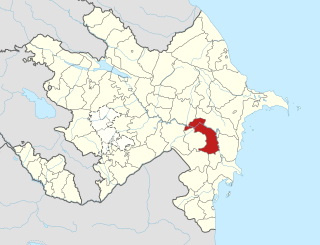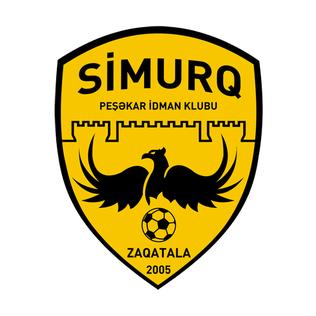
Talysh People are an Iranian ethnic group indigenous to a region shared between Azerbaijan and Iran which spans the South Caucasus and the southwestern shore of the Caspian Sea. They speak the Talysh language, one of the Northwestern Iranian languages. It is spoken in the northern regions of the Iranian provinces of Gilan and Ardabil and the southern parts of the Republic of Azerbaijan. Northern Talysh was historically known as Talish-i Gushtasbi. In Iran there is a Talesh County in Gilan Province.

Sabirabad District is one of the 66 districts of Azerbaijan. It is located in the centre of the country and belongs to the Aran Economic Region. The district borders the districts of Saatly, Imishli, Kurdamir, Hajigabul, Salyan, Bilasuvar, and the city of Shirvan. Its capital and largest city is Sabirabad. As of 2020, the district had a population of 178,800.

Talysh-Mughan officially known as the Talysh-Mughan Autonomous Republic was a short-lived autonomous republic in Azerbaijan, that lasted from June to August 1993.

Simurq PIK was an Azerbaijani football club based in Zaqatala, that competed in the Azerbaijan Premier League.

Mugan plain is a plain in northwestern Iran and the southern part of the Republic of Azerbaijan. The highest density of irrigation canals is in the section of the Mugan plain which lies in the Republic of Azerbaijan. It is located on the bank of the Aras river extending to Iran.

FK Mughan Salyan was an Azerbaijani football club, based in Salyan. The club reached the Azerbaijan Premier League for the first time in 2008–2009. The club was first promoted after FK Masallı withdrew for the 2008/09 season. On 31 October 2008, FK NBC Salyan changed its name to FK Mughan.
Muğanlı or Mughanly or Mughanli or Mughanlu or Moughanly may refer to:

Qalaqayın is a village and the most populous municipality, except for the capital Sabirabad, in the Sabirabad Rayon of Azerbaijan. It has a population of 7,658.
The fortress of the historic Javad Khanate and the center of the Mughan district.

Xaspoladoba is a village and municipality in the Khachmaz District of Azerbaijan. It has a population of 1,837. The municipality consists of the villages of Khaspoladoba, Babali, Azizli, and Ganjali.

Gəncəli is a village in the Khachmaz District of Azerbaijan. The village forms part of the municipality of Khaspoladoba.

Mughan is a village and the least populous municipality in the Bilasuvar District of Azerbaijan. It has a population of 310.

Muğan is a village and municipality in Hajigabul District of Azerbaijan. Mughan is the most populous municipality of the district except for the capital Hajiqabul. It has a population of 4,668.

Muğanlı is a village and municipality in the Sharur District of Nakhchivan Autonomous Republic, Azerbaijan. It is located 4 km away from the district center, on the plain. Its population is busy with grain-growing, tobacco-growing, vegetable-growing, foddering, vine-growing and animal husbandry. There are secondary school, library, club, mosque and a medical center in the village. It has a population of 1,090.
Salyan Olympic Sport Complex Stadium is located in Salyan, Azerbaijan. It is used by FK Mughan and has a seating capacity of 2000 spectators.
The 2010–11 Azerbaijan Premier League was the nineteenth season of the Premier League since its establishment in 1992. The fixtures were announced on 29 July 2010; the season began on 7 August 2010 and ended on 28 May 2011. Neftchi Baku were the eventual champions, winning their first Azerbaijani championship since 2005.
The Mughan culture or the Talish-Mugan culture is an archeological culture of the late Bronze Age and the early Iron Age epoch in the Mugan plain and the Talysh Mountains in northwest Iran and Southeast Azerbaijan.

Javad Khanate was a khanate in the territory of modern Azerbaijan with its capital in the town of Javad. It extended from Javad on the Kura River southwest along the east side of the Aras River. It was bordered by Shamakhy Khanate (north), Karabakh Khanate (west), Karadagh khanate (southwest), Talysh Khanate (south), and Salyan Sultanate (east).
Vladimir Țaranu is a Moldovan footballer who last played as a forward for Iskra-Stal.
Tālīsh is a region that stretches north from the Sefīd-Rūd river, which cuts through the Alborz mountains in Iran's Gilan Province, to the Aras river in the south of Azerbaijan. The region is inhabited by the Talish people who speak the Talish language. The territory and the language set apart Talish from its neighbors.

Talyshstan is a historically and nowadays term denoting "the country of Talysh". It is also sometimes used to avoid homonymy with the name of the ethnos itself, Talysh, according to the common model of forming the names of territories and countries with the suffix -stan. Divided into two parts: Northern Talyshstan in Azerbaijan and Southern Talyshstan in Iran.In the north, it adjoins the Mugan plain in Azerbaijan and stretches in a narrow strip along the southern coast of the Caspian Sea to the settlement of Kopulchal, located near the port of Anzali in Iran. Talyshstan is also sometimes referred to as the Talysh-Mugan Autonomous Republic, which was declared in 1993. The term Talyshstan was historically met by a number of medieval authors in relation to the region in Gilan. The medieval cartographer Mohammad Saleh Esfahani used the term "Talyshstan" already in 1609 in relation to Gilan. The toponym "Talyshstan" in the Lahijan County (Gilan,Biye-pis), inhabited by the Talysh, is used by Abd-Al-Fattah Fumeni in his work "The History of Gilan".











